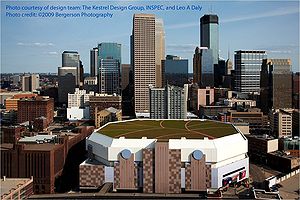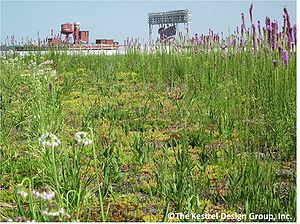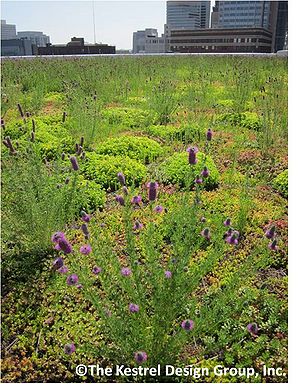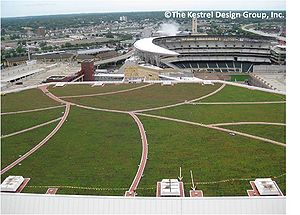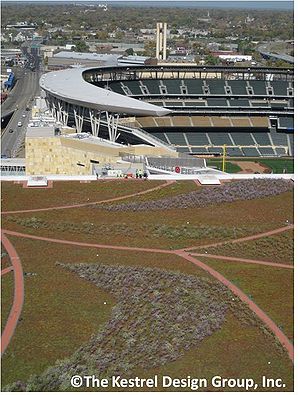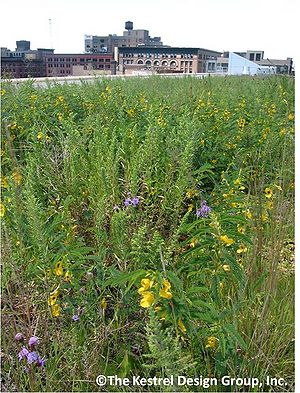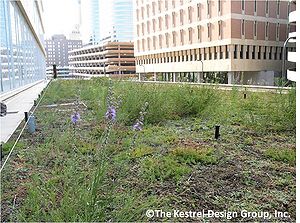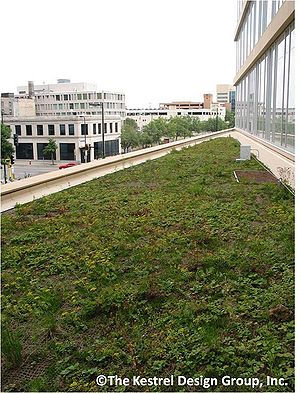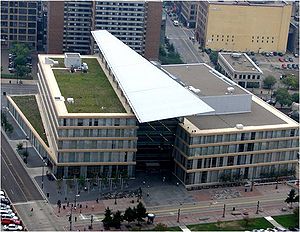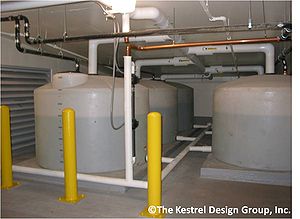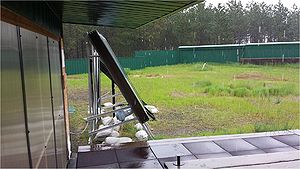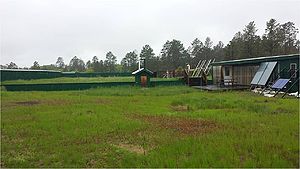
Difference between revisions of "Case studies for green roofs"
m |
|||
| Line 120: | Line 120: | ||
The Hunt Utilities green roof is an example of a green roof outside of the Metro area, and is also unique in that it was not planted, but the owners just let it be colonized by whatever plants came in naturally. | The Hunt Utilities green roof is an example of a green roof outside of the Metro area, and is also unique in that it was not planted, but the owners just let it be colonized by whatever plants came in naturally. | ||
| − | [[File:Hunt Utilities Group Green Roof 1.jpg|300px|left|thumb|alt=image of Hunt Utilities Group green roof|<font size=3>Hunt Utilities Group Green Roof | + | [[File:Hunt Utilities Group Green Roof 1.jpg|300px|left|thumb|alt=image of Hunt Utilities Group green roof|<font size=3>Hunt Utilities Group Green Roof, Image Courtesy of Ryan Hunt</font size>]] |
| − | [[File:Hunt Utilities Group Green Roof 2.jpg|300px|thumb|alt=image of Hunt Utilities Group green roof|<font size=3>Hunt Utilities Group Green Roof | + | [[File:Hunt Utilities Group Green Roof 2.jpg|300px|thumb|alt=image of Hunt Utilities Group green roof|<font size=3>Hunt Utilities Group Green Roof, Image Courtesy of Ryan Hunt</font size>]] |
| − | [[File:Hunt Utilities Group Green Roof | + | [[File:Hunt Utilities Group Green Roof Details, courtesy of Ryan Hunt.jpg|300px|thumb|alt=image of Hunt Utilities Group green roof|<font size=3>Hunt Utilities Group Green Roof Details, Courtesy of Ryan Hunt</font size>]] |
“When the Hunt Utilities Group's Resilient Living Campus needed a prototyping and fabrication shop, we decided on a living roof for it, primarily so we could gain the experience and demonstrate it. The additional, unique green space and limiting water run off was also an interest. We learned that it requires some serious structure, and that making sure it is all done extremely well to prevent expensive, hard to find leaks is critical. Fortunately, we have not experienced any leaks, yet. We have found the space useful for solar panel testing and watching shooting stars” (Ryan Hunt). | “When the Hunt Utilities Group's Resilient Living Campus needed a prototyping and fabrication shop, we decided on a living roof for it, primarily so we could gain the experience and demonstrate it. The additional, unique green space and limiting water run off was also an interest. We learned that it requires some serious structure, and that making sure it is all done extremely well to prevent expensive, hard to find leaks is critical. Fortunately, we have not experienced any leaks, yet. We have found the space useful for solar panel testing and watching shooting stars” (Ryan Hunt). | ||
Revision as of 16:15, 17 July 2013
Contents
Target Center Arena Green Roof
When Minneapolis’ Target Center Arena needed a new roof, the City of Minneapolis chose to model a sustainable building and stormwater management approach by re-roofing with a green roof. At 113,000 square feet, the Target Center Arena green roof was the fifth largest extensive green roof at the time of design and the first green roof installed on an arena in North America. The green roof mitigates the urban heat island effect, provides greens views from above, provides wildlife habitat, and improves urban air quality on a scale that is not feasible at grade in an ultra-urban area like the site of the Target Center Arena in downtown Minneapolis. It also mitigates stormwater runoff from a significant amount of previously impervious surface in a downtown location where space does not permit use of other Low Impact Development (LID) techniques for stormwater management at grade. Such positive impacts on local water bodies are valuable in a City that prides itself on its legendary waterbodies - The City of Lakes in the Land of 10,000 Lakes.
The design process began with a quantitative and qualitative lifecycle cost benefit analysis that enabled the City of Minneapolis to decide with confidence that replacing the conventional roof on the Target Center with a green roof was the most cost effective and ecologically sound decision over the lifespan of the proposed roof. Quantitative financial lifecycle cost benefit analysis showed that over a 20 year study period, a green roof is more cost effective than a white reflective or a traditional roof.
A state-of-the-art waterproofing membrane was used to withstand constant dampness, high alkalinity, and exposure to plant roots, fungi and bacterial organisms as well as varying hydrostatic pressures. To test for leaks and facilitate pinpointing the exact location of leaks throughout the roof’s lifespan so that the amount of overburden removed can be minimized, an Electro Field Vector Mapping (EFVM) leak detection system was installed.
One of the most difficult challenges at this site was structural. At 17.4 pounds per square foot on most of the roof, the Target Center’s dead load capacity is much lower than that of a typical green roof. The designers aimed to maximize stormwater holding capacity and plant resilience on a roof with very limited structural capacity. Because this is a public, highly visible project, designing an aesthetically captivating roof that succeeds right away was another especially important objective.
Design strategies used to achieve these design objectives include:
- choosing a mat pre-grown at grade to allow plants to establish before facing the harsh conditions on the roof; as well as to maximize plant cover and wind resistance 150 feet up in the air;
- requiring a lightweight growing medium;
- including drip irrigation and a water retention layer to compensate for the minimal soil depth available to hold water;
- maximizing plant diversity and adding native plugs and seed to maximize resilience to climate extremes, diseases, and pests;
- adding bold sweeps of native plant plugs to not only increase resilience and ecological benefits, but also make a bold aesthetic statement; and
- shaping the firebreaks as a metaphorical leaf, river, or basketball, to not only meet functional requirements prescribed by the insurance company, but also add a powerful aesthetic element.
The Target Center green roof consists of a 2.75 inch deep growing zone in the center of the main arena roof structure and a deeper 3.5-inch growing zone around the perimeter where the structural capacity is greater. The pregrown Sedum mat was supplemented with 22 species of plugs and 16 species of seed native to Minnesota’s bedrock bluff prairies, a plant community with harsh growing conditions similar to the growing conditions on the Target Center Green Roof. As of 2012, the green roof’s fourth growing season, a diversity of sedum species, plugs, as well as species germinated from seed were thriving on the roof.
- Year built: 2009
- Location: Minneapolis, MN, USA
- Building Type: Public
- Green Roof Type: Extensive
- Size: 113,000 square feet (2.6 acres)
- Slope: 1 percent
- Materials used in and components of the green roof (above membrane):
- 80 mil-PVC waterproofing membrane
- Insulation
- Coverboard
- Leak detection system
- Pavers
- Extensive growing medium
- Drainage sheet of post-industrial recycled polypropylene drainage core of fused, entangled filaments and a geocomposite fabric bonded to each side
- Capillary drip irrigation system that uses capillary action to evenly distribute water throughout the growing medium
- Soil moisture sensor to inform when growing medium is dry enough to need watering
- Pregrown Sedum vegetation mat
- 22 species of plugs and 16 species of seed native to Minnesota’s bedrock bluff prairies, a plant community with harsh growing conditions similar to the growing conditions on the Target Center Green Roof
- Plant list: The pregrown Sedum mat was supplemented with 22 species of plugs and 16 species of seed native to Minnesota’s bedrock bluff prairies, a plant community with harsh growing conditions similar to the growing conditions on the Target Center Green Roof.
- Documented maintenance practices: weeding, irrigation, and plant replacement as needed
- Unit cost: 15 per square foot, includes green roof, irrigation, and leak detection; excludes maintenance costs
- Owner: City of Minneapolis
- Designers and installers:
- Landscape Architect/Greenroof Designer: Kestrel Design Group, Inc.
- Roofing Consultant: Inspec
- Architect: Leo Daly
- Irrigation: Hydrologic Design
- General Contractor: Stock Roofing, a Tecta America Company
- Electric Field Vector Mapping (EFVM): International Leak Detection (ILD)
- Irrigation: KISSS
- Access: Not accessible
- For more information, see:
- greenroofs.com project database
- Minnesota Green Roofs Council case studies
Minneapolis Central Library
Description: The Minneapolis Central Library has three green roofs that each have very different microclimates:
- 15,868 square feet of green roof on the building’s top (5th) floor, exposed to full sun
- 2436 square feet of green roof on the building’s 2nd floor, facing south, exposed to full sun plus reflection from an adjacent glass curtain wall
- 363 square feet of green roof facing northwest, with only partial sun exposure
The plant palette and irrigation system of each roof is tailored to the growing conditions on that roof: More drought tolerant species were planted on the 2nd floor roof that faces south, while more shade tolerant species were used on the 2nd floor roof facing southwest.
To maximize irrigation efficiency, a drip irrigation system was used on the 5th floor and the 2nd floor roof that faces northwest. On the 2nd floor roof that faces south, adjacent to a south facing glass curtain wall, a popup sprinkler system is used to help cool plants in addition to watering them. Visitors to the library can view one of the green roofs from windows on 2nd floor, and all roofs are visible from surrounding buildings.
The primary driver behind these green roofs was their ability to provide sustainable stormwater management on a site where little space is available for stormwater management at grade. Further minimizing negative effects of roof runoff on downstream water bodies, the Central Library Green Roof is equipped with a cutting edge irrigation system that utilizes 7,500 gallon capacity cistern system to collect, store, and distribute harvested rainwater for use by the plants. This irrigations system is powered by a solar pump, and is intended for use on the green roof only during the plant establishment period and during periods of extreme drought. When the roof does not need watering, roof runoff collected in the cisterns is also be used to irrigate at grade landscape.
The conceptual design for the Minneapolis Central Library’s green roof connects culture and nature, weaving together local cultural and natural patterns. The concept emphasizes the influence of the Mississippi River on Minneapolis’ street grid and building design, as the flow of the Mississippi River is emulated by waves created across plant palettes of varying, undulating heights, with 20-30 species in each palette. Wave patterns change as different waves will be more apparent at different times of the year when prominent species are in bloom. A seasonal wave movement is also superimposed on 3D wave patterns by a purple/pink burst of color that moves from west to east from spring to fall in accordance with flow of Mississippi River. The planting design also complements the frit patterns and geometry of the library windows. The metaphorical connection of the green roof design to the Mississippi River highlights the positive impact of the green roof as it mitigates the effect of storm water runoff from the roof on the Mississippi River.
- Year built: 2005
- Location: Minneapolis, MN
- Building Type: Public
- Green Roof Type: Extensive
- Size: 18,667 square feet.
- Slope: 1 percent
- Materials used in and components of the green roof (above membrane):
- Root barrier/synthetic drainboard/filter fabric composite
- 4 inches depth of extensive growing medium, which is the maximum depth that could be accommodated by the roof’s structural capacity
- Erosion control blanket
- Pop-up irrigation system and temperature sensor on the roof with the most extreme sun exposure, *drip irrigation on both the other green roofs; soil moisture sensors on all roofs
- Plant list: Eighteen sedum species, which are traditionally used on European green roofs, were combined with 41 grasses and forbs that are native to Minnesota’s bluff prairies, a habitat template similar, in many ways, to conditions found on extensive green roofs.
- Documented maintenance practices: irrigation and weeding as needed
- Unit cost: 28 per square foot (includes fall protection, paving, and other atypical green roof costs)
- Owner: City of Minneapolis
- Designers and installers:
- The Kestrel Design Group, Inc., Landscape Architect/Green Roof Designer
- Cesar Pelli & Associates Architects: Design Architect
- Architectural Alliance: Architect of Record
- Ambe, Ltd.: Roofing Consultant
- Hydrologic, Irrigation Design
- Mortensen/Thor: Construction Manager
- Rosenquist Construction: Green Roof Contractor
- Berwald Roofing: Roofing Contractor
- Aloha Landscaping: Green Roof Plants Installation
Hunt Utilities Group green roof
- Description
The Hunt Utilities green roof is an example of a green roof outside of the Metro area, and is also unique in that it was not planted, but the owners just let it be colonized by whatever plants came in naturally.
“When the Hunt Utilities Group's Resilient Living Campus needed a prototyping and fabrication shop, we decided on a living roof for it, primarily so we could gain the experience and demonstrate it. The additional, unique green space and limiting water run off was also an interest. We learned that it requires some serious structure, and that making sure it is all done extremely well to prevent expensive, hard to find leaks is critical. Fortunately, we have not experienced any leaks, yet. We have found the space useful for solar panel testing and watching shooting stars” (Ryan Hunt).
- Year built: 2005
- Location: 2330 Dancing Wind Road, Pine River, MN 56474
- Building Type: (public or private) Private
- Green Roof Type: Semi-intensive (Approximately 6" deep)
- Size: approximately 15,000 Sq Ft
- Slope: Flat
- Materials used in and components of the green roof (above membrane):
Multi-layer system by Carlisle
- Plant list: Whatever grew there
- Documented maintenance practices: None
- Unit cost: The cost was about 22 per square foot including additional structural support.
- Owner: Hunt Utilities Group
- Designers and installers:
- Multi-layer system designed by Carlisle
- Architect: Paul Hirst
- Installed by: Hunt Utilities Group
For more information:
Additional case studies
References
- Argenti, K. 2013. Personal communication.
- Belizario, N.A. 2013. Personal communication.
- Durhman, A. 2013. Personal communication.
- Compton, J. S., and T. H. Whitlow. 2006. A Zero Discharge Green Roof System and Species Selection to Optimize Evapotranspiration and Water Retention. Greening Rooftops for Sustainable Communities, Boston, MA, May 11-12, 2006.
- Compton, Jeannette. 2006. Rethinking the Green Roof. Biocycle, September: 38-41.
- Greenroofs.com project database at http://www.greenroofs.com/projects/pview.php?id=514, downloaded 05/28/2013
- Hunt, R. 2013. Personal Communication.
